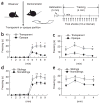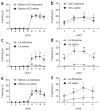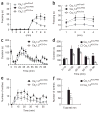Observational fear learning involves affective pain system and Cav1.2 Ca2+ channels in ACC
- PMID: 20190743
- PMCID: PMC2958925
- DOI: 10.1038/nn.2504
Observational fear learning involves affective pain system and Cav1.2 Ca2+ channels in ACC
Abstract
Fear can be acquired vicariously through social observation of others suffering from aversive stimuli. We found that mice (observers) developed freezing behavior by observing other mice (demonstrators) receive repetitive foot shocks. Observers had higher fear responses when demonstrators were socially related to themselves, such as siblings or mating partners. Inactivation of anterior cingulate cortex (ACC) and parafascicular or mediodorsal thalamic nuclei, which comprise the medial pain system representing pain affection, substantially impaired this observational fear learning, whereas inactivation of sensory thalamic nuclei had no effect. The ACC neuronal activities were increased and synchronized with those of the lateral amygdala at theta rhythm frequency during this learning. Furthermore, an ACC-limited deletion of Ca(v)1.2 Ca(2+) channels in mice impaired observational fear learning and reduced behavioral pain responses. These results demonstrate the functional involvement of the affective pain system and Ca(v)1.2 channels of the ACC in observational social fear.
Conflict of interest statement
The authors declare no competing financial interests.
Figures






Comment in
-
Mouse brains wired for empathy?Nat Neurosci. 2010 Apr;13(4):406-8. doi: 10.1038/nn0410-406. Nat Neurosci. 2010. PMID: 20348937 No abstract available.
References
-
- Olsson A, Phelps EA. Social learning of fear. Nat Neurosci. 2007;10:1095–1102. - PubMed
-
- LeDoux JE. Emotion circuits in the brain. Annu Rev Neurosci. 2000;23:155–184. - PubMed
-
- Phelps EA, LeDoux JE. Contributions of the amygdala to emotion processing: from animal models to human behavior. Neuron. 2005;48:175–187. - PubMed
-
- Adolphs R. Cognitive neuroscience of human social behavior. Nat Rev Neurosci. 2003;4:165–178. - PubMed
Publication types
MeSH terms
Substances
Grants and funding
LinkOut - more resources
Full Text Sources
Other Literature Sources
Medical
Molecular Biology Databases
Miscellaneous

